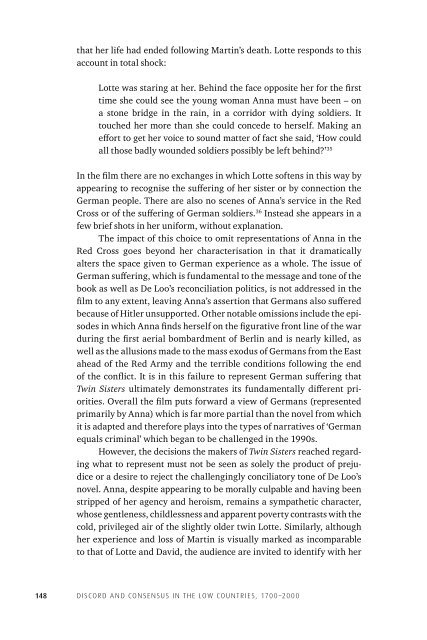Discord Consensus
7aze300jFJo
7aze300jFJo
You also want an ePaper? Increase the reach of your titles
YUMPU automatically turns print PDFs into web optimized ePapers that Google loves.
that her life had ended following Martin’s death. Lotte responds to this<br />
account in total shock:<br />
Lotte was staring at her. Behind the face opposite her for the first<br />
time she could see the young woman Anna must have been –on<br />
a stone bridge in the rain, in a corridor with dying soldiers. It<br />
touched her more than she could concede to herself. Making an<br />
effort to get her voice to sound matter of fact she said, ‘How could<br />
all those badly wounded soldiers possibly be left behind?’ 35<br />
In the film there are no exchanges in which Lotte softens in this way by<br />
appearing to recognise the suffering of her sister or by connection the<br />
German people. There are also no scenes of Anna’s service in the Red<br />
Cross or of the suffering of German soldiers. 36 Instead she appears in a<br />
few brief shots in her uniform, without explanation.<br />
The impact of this choice to omit representations of Anna in the<br />
Red Cross goes beyond her characterisation in that it dramatically<br />
alters the space given to German experience as a whole. The issue of<br />
German suffering, which is fundamental to the message and tone of the<br />
book as well as De Loo’s reconciliation politics, is not addressed in the<br />
film to any extent, leaving Anna’s assertion that Germans also suffered<br />
because of Hitler unsupported. Other notable omissions include the episodes<br />
in which Anna finds herself on the figurative front line of the war<br />
during the first aerial bombardment of Berlin and is nearly killed, as<br />
well as the allusions made to the mass exodus of Germans from the East<br />
ahead of the Red Army and the terrible conditions following the end<br />
of the conflict. It is in this failure to represent German suffering that<br />
Twin Sisters ultimately demonstrates its fundamentally different priorities.<br />
Overall the film puts forward a view of Germans (represented<br />
primarily by Anna) which is far more partial than the novel from which<br />
it is adapted and therefore plays into the types of narratives of ‘German<br />
equals criminal’ which began to be challenged in the 1990s.<br />
However, the decisions the makers of Twin Sisters reached regarding<br />
what to represent must not be seen as solely the product of prejudice<br />
or a desire to reject the challengingly conciliatory tone of De Loo’s<br />
novel. Anna, despite appearing to be morally culpable and having been<br />
stripped of her agency and heroism, remains a sympathetic character,<br />
whose gentleness, childlessness and apparent poverty contrasts with the<br />
cold, privileged air of the slightly older twin Lotte. Similarly, although<br />
her experience and loss of Martin is visually marked as incomparable<br />
to that of Lotte and David, the audience are invited to identify with her<br />
148<br />
DISCORD AND CONSENSUS IN THE LOW COUNTRIES, 1700–2000


